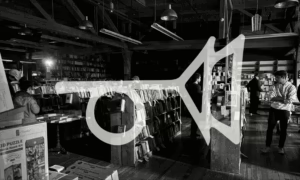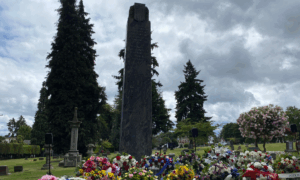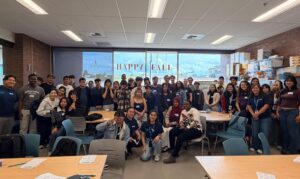More than 50 people filled conference room A on Thursday at noon. Opening and hosting the discussion was Clarence Moriwaki, who boasts many titles such as founder of the Japanese Exclusion Memorial, and former aide to U.S. President Bill Clinton. Moriwaki began the COSI talk with a brief history of Bainbridge Island, which for 11,000 years was occupied by the Snoquamish peoples. The island takes its name not from a Snoquamish word, however, but after a friend of Charles Wilkes, a naval officer who came to the island around 1842, as Moriwaki explained.
Moriwaki, maintaining a rather commanding and entertaining stride throughout, went on to detail the community that developed on the small island. A community that developed into a thriving port city known as Blakeley Harbor. This community consisted largely of Japanese-Americans, largely due to a severe recession that gripped Japan in the latter half of the nineteenth century. The lumber mill which formed the city’s economic centre grew to be the largest one on the West Coast.
Forestry was so abundant, that another town, consisting almost solely of Japanese-American citizens, soon followed, and then a third. Yama (Japanese for “mountain,” where the town was established) would eventually transition to rolling farmland; strawberries would become among the island’s more abundant produce.
Washington as a whole would change, too. It was one of the few states to mandate education during the 1920s. As Moriwaki put it, the children who attended school on the island became friends. Race wasn’t an issue. They had a community of their own. Then, just twenty years later, it would all come to an end.
On December 7th, 1941, Pearl Harbor was attacked by the Empire of Japan, an act which would eventually prompt the U.S. to enter World War II. Just twenty-four hours after the attack, the FBI arrested 1,291 Japanese-American citizens throughout 23 cities. There was no evidence; there were no warrants. A nationwide curfew was enacted for Japanese civillians. On February 19th, 1942, President Roosevelt signed Executive Order 9066 into law. The military were legally allowed to detain those of 1/16th Japanese heritage without cause. It was quite literally open season.
Moriwaki paused here. A photo of a smiling couple appeared on the wall. The photo was of the Moji family: A husband, wife, and their dog King. They would be legally and forcibly separated when the community of Bainbridge Island was raided. King, who had never tried to bite a single human, had tried to bite the soldiers when they detained his family. He became moody and refused to eat. After a week of separation from the Mojis, King died.
The soldiers, who themselves couldn’t understand the need for the sudden relocation of two hundred Americans, were just as distraught. Having spent more than a month gathering up and shipping away the island’s residents, the soldiers had taken to them fondly. Another community gone, as Moriwaki put it.
Of the three concentration camps in the Pacific Northwest, Manzanar would hold the citizens of Bainbridge. It was an arduous trek from a military transport truck, to a train, and finally a bus. Arriving at Manzanar in the middle of the desert, the Bainbridge citizenry was greeted by a sprawling 504-bunker encampment. Each bunker, with walls similar to a barn, measured just 60×25, and was designed to hold eight people. There was a single light in the center of each “house.” On arrival, the occupants were given two sacks and told to fill them with hay. These would serve as their mattress and pillow for the duration of internment. Community toilets featured no privacy barriers. The raw, wooden walls provided no insulation in the winter. In spite of this, people imprisoned in the camps attempted to make their lives as much like home as possible. In particular, one activity served as a particularly unifying force for all three camps: Baseball.
As U.S. citizens, Moriwaki went on, the concentration camp residents were eligible for the draft. A pre-draft loyalty questionnaire asking draftees if they would forswear loyalty to the Emperor was often met with the response, “Who is the Emperor?” Of the remaining Bainbridge citizens, 68 were drafted or volunteered. The 442nd Battalion would consist entirely of Japanese-Americans, many of whom had families suffering in remote, inhumane detention centers.
Here, Moriwaki posed a question to the audience: as Italy was another country with which America was at war, what if the same conditions imposed on Japanese-American citizens were also set upon Italian-Americans? Eisenhower might never have lead America to victory on five separate occasions. There may never have been a famous Joe Dimaggio. Moriwaki, as an aside, noted that in the original raids conducted by the FBI (then headed by J. Edgar Hoover) no evidence of treason was found. Hoover would comment later that, unlike President Roosevelt, he was more concerned with a growing American offshoot of the Nazi party called the Bund, which was gaining support in the Northeast.
In their effort to justify the abrupt internment of 120,000 Japanese civillians across the U.S., the Supreme Court faced what seemed like an uphill battle. It was illegal to detain citizens without cause. The hunting licenses handed out to Marines encouraging them to go “open season” on those with Japanese ancestry illustrated the solution pretty succinctly. Japanese people were no longer citizens. They were “aliens.” As Moriwaki cycled through the caricatures that circulated during the time, he would occasionally include pictures of modern propaganda that appeared online in the wake of September 11th. Less delicate variants of the idea to “ban Muslims’ flashed across the screen alongside 80-year-old declarations that Japanese-Americans were subhuman traitors. One image portrayed a rat next to the phrase, “Alaska, a death trap for Jap Rats.” “Japanazis” posters were interspersed with “nuke Mecca.”
After the war, the Bainbridge community held strong, with 150 of 276 returning to their island. Gerald Ford would officially rescind EO 9066, and Executive Order permitted Japanese persons to be legally interred. Today, the Exclusion Memorial stands to commemorate those imprisoned in America’s concentration camps. It stands with the hallmark “nidoto nai yoni,” or, “let it not happen again.” As Moriwaki closed the COSI talk, every audience member, who had remained silent and transfixed for its entire duration, applauded.
For more information on the Memorial, as well as directions, click here.







Be First to Comment